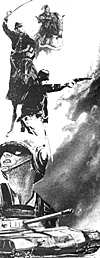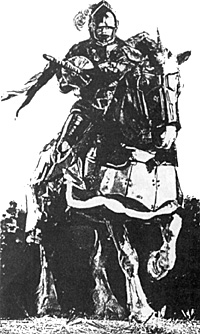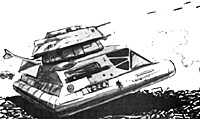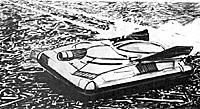 During the time in earth's history known as the Middle Ages,
cavalrymen were wealthy knights and nobles, because they were the
only members of society who could afford to own horses. The commonly
accepted idea of cavalry tactics in that day and age was to line up all of
your horsemen and charge headlong into the enemy's cavalry, because
they were considered to be the only worthy opponents. The foot soldiers
were regarded as part of the scenery.
During the time in earth's history known as the Middle Ages,
cavalrymen were wealthy knights and nobles, because they were the
only members of society who could afford to own horses. The commonly
accepted idea of cavalry tactics in that day and age was to line up all of
your horsemen and charge headlong into the enemy's cavalry, because
they were considered to be the only worthy opponents. The foot soldiers
were regarded as part of the scenery.
As time went on, armies became somewhat more standardized and thereby better organized. The role played by cavalry on the battlefield began to change. Heavily armored cavalry still existed in the knights and nobles, but another type of horseman appeared on the battlefield. The new cavalry troops didn't wear the cumbersome plate armor of the knights, nor did they use the heavy lance and broadsword commonly wielded by the heavy cavalry. The lance in particular was shockingly effective in the massed charge which was the favored tactic of the knights. When these new mounted soldiers wore armor at all, it was usually a leather jack or a light chainmail sark. Their weapons we a smaller, lighter lance, a long sword, or an axe. Sometimes these light cavalrymen carried bows or javelins, weapons with which to harass and cripple their opponents from a distance--a type of warfare knights considered dishonorable. The horses used by these fighters were also smaller, lighter, and much faster than the huge destriers of the armored knights.
Unlike the mounted knights, the light cavalry did not engage in wild charges. Instead, they were assigned to accomplish specific tasks. Among these tasks were: gather and relay information, disrupt the enemy's communications, destroy the enemy's stores, neutralize enemy cavalry, deny the enemy access to his reserves, disrupt the enemy unit's integrity, and prevent scattered enemy units from reforming. The armies and the battlefield of the 3111 Century are not so different from those of the Middle Ages. Where once rode the armored knights, now MechWarriors thunder across the land in the BattleMechs. And where the light horsemen skirmished with harried formations of heavy infantry, now the newest breed of cavalryman rides his iron steed into battle against his massive, armored foe. He, too, is a light cavalryman, and his mount is a fast-moving armored cavalry vehicle.
For the purpose of this discussion, we may define a light cavalry lance as consisting of 4 fast-moving, armored vehicles, such as the J. Edgar or the Pegasus hovertank. A typical light cavalry vehicle has a cruising speed of 70 kph or more and car ries an assortment of weapons. Its armo tends to be on the light side, but this is in keeping with the nature of cavalry tactics and applications. Most VTOLs fall into this category as well.
Light recon 'Mechs, like the Locust or Ostscout, on the other hand, do not actually qualify as light cavalry vehicles, on the basis of their tactical application. Generally, BattleMechs of any weight are most often used in "stand and fight" style combats with other 'Mechs, while light cavalry vehicles are best used for quick hit-and-run operations.
In order to fully appreciate the value of a well-trained, well-organized unit of light cavalry, we should examine each of the applications and tactics in turn.
APPLICATIONS
 Gather and relay information
Gather and relay information
By sending scout riders ahead and to the sides of an advancing column, a unit commander can extend his eyes and ears for a long way. These men were generally lightly armed and armored, and mounted on the fastest horses available. In this role, light cavalrymen roamed far afield from the main body, keeping watch for signs of enemy activity. When traces of the enemy were found, they hastened back to report what they had discovered to their commander. Often, scouting sorties such as these became horse races between scout and enemy patrols. Such patrols were often sent out from fixed positions for exactly the same reason-to gather and relay information.
Today, in the 31st Century, the task of gathering and relaying information has mostly been given over to reconnaissance satellites and aircraft; however, cavalry recon units remain a valuable part of any army. A recon lance of BattleMechs usually consists of 4 light, jump-capable 'Mechs fitted with sophisticated electronic equipment. Non-'Mech recon units are generally made up of fast-moving, lightly-armored vehicles, such as the Swift Wind or the Harrier. These vehicles, like the scouts of old, move far ahead of the unit they are scouting for.
Right: A Medieval armored cavalryman. The armies and the battlefield of the 31st Century are not so different from those of the Middle Ages.
Once contact with the enemy has been made, it is the responsibility of the cavalry commander to assess the strengths of the enemy, determine the makeup and identity of the unit he is observing, etc. Then he must relay all of this information back to the commander of the main body. During the second battle of Karia on the Davion-held world of Royal, cavalry recon units attached to the invading Kurita forces encountered a battalion of heavy and medium 'Mechs moving through the rocky hills north of the city of Karia.
After determining the strength and identity of the Davion forces by lying concealed amidst the rocks and observing them for nearly an hour, the recon unit sped back to their own lines. Their report enabled the Combine forces in Karia to alter their defensive position. When the Davion 'Mechs attacked the city, the Kurita forces repulsed them easily. Twice more, the Davion forces attacked, each time from different directions, but each time they were beaten back, because the Kurita cavalry units shadowed them and advised the garrison commander which direction the assault would come from.
Karia fell at last when the Davion commander order a massive airstrike on the Kurita positions in and around the city.
Disrupt enemy communications
If cavalry scouts were the eyes of a Medieval army, then the best way of blinding that army was to eliminate those scouts. Often cavalry scouts from one army would be detailed to run down scouts from the other army to prevent them from relaying their information. Often, too, cavalry units would be used to eliminate post riders, runners, and other messengers carrying communiquds between enemy units. During the American Civil War on earth, cavalry divisions were also responsible for the destruction of railways, telegraph lines, and bridges. Not only did these attacks disrupt communications, but the demolition of rail lines and bridges also delayed or prevented troop movement from one location to another.
In these times of electronic communication, this particular aspect of cavalry tactics has, for the most part, been eliminated.
However, in the case of the second battle of Karia, cited above, had the Davion forces cavalry units of their own, and had those cavalry units caught and destroyed those from the Draconis Combine, the face of the battle would have undergone a radical change. Some tactical experts have even gone so far as to state that the battle for Karia was actually won by two lances of Kurita cavalry vehicles.
Of course, railway lines and bridges remain attractive targets for cavalry raids.
 Destroy Stores
Destroy Stores
An army without supplies is no army. When a shortage of vital materiel--such as ammunition, replacement parts, clothing, and food--develops, the individual members of an army tend to wander off, foraging for whatever supplies they can find. This is doubly true of mercenaries who, if they do not receive the supplies stipulated in their contract, have the nasty habit of refusing to fight. Just such an incident occurred when a Steiner cavalry company destroyed several convoys of supply trucks destined for Morrison's Division, a mercenary unit hired by the Draconis Combine to garrison a fortified town in the mountains of New Wessex.
The mercenaries had been standing off a siege by the Lyran invaders for many weeks. Supplies of ammunition, spare parts, medical supplies, and food were running short. Four attempts to supply the garrison were foiled by cavalry raids on the convoys. A fifth failed when a Leopard-class DropShip was shot down by Commonwealth fighters. At that point, the mercenaries simply laid down their arms and surrendered the beleaguered town to the Steiner forces.
An added bonus to this particular usage of cavalry is the possibility of not destroying but capturing the enemy's supplies for use by friendly forces. If the mercenaries of Morrison's Division had been able to mount a raid on a Steiner supply depot, they might have been able to hold out indefinitely.
 Neutralize enemy cavalry
Neutralize enemy cavalry
As this article demonstrates, a well-trained, properly-employed cavalry unit can be an effective tool in any military operation. It is imperative that a cavalry commander learn to deal with his opposite number in the enemy forces. When a cavalry unit is detailed to act as a screen for a heavy unit, the cavalry commander must assess the situation and deploy his cavalry screen in the manner which best fits the potential threat.
Usually, this means taking up a position near the center of the heavy unit he has been assigned to protect. If the heavy unit is on the march, cavalry screens are placed ahead of and on the flanks of the advancing column. Whatever the deployment of a cavalry screen, when the threat of enemy cavalry is present, the screen commander should wait until the enemy has committed himself to an attack before making his counter-charge. The timing of a counter-charge must be precise. Too soon, and the enemy will have time to alter his own charge. Too late, and there may not be enough momentum to the counter-charge to stop or turn aside the onrushing enemy cavalry.
Once an enemy charge has been broken, and the threat of enemy cavalry neutralized, it is imperative that the cavalry screen return to the post and not pursue the fleeing enemy.
A cavalry troop assigned to screen a heavy unit of the Kurita Legion of Vega chased a withdrawing Davion cavalry platoon attached to the Eridani Light Horse for nearly 4 kilometers. They returned to their unit to find that other elements of the Light Horse had attacked and overrun the column in their absence. When the Vegan cavalry tried to escape, the same Davion unit which had decoyed them away from the column caught and defeated them.
Deny the enemy access to reserves
An army's reserves are just as important to it as its supplies. As units and individuals are eliminated, their places are taken by reserves and replacements. Denying the enemy access to his reserves limits the numberof enemy effectives which a unit commander will have to face. Usually, reserves are held back not far from the actual line of battle and are committed to the fighting as either the battle plans or the situation dictates.
Replacements, on the other hand, are generally held in a rear area and are sent up to a unit during a lull in the fighting to take the place of casualties. A cavalry unit need not actuallyclestroy an enemy's reserves or replacements. In some cases, it is sufficient merely to delay or cripple these reinforcements. The officer in charge of a cavalry platoon assigned to attack enemy reserves had better know his job and had better be capable of responding to any situation which develops, because he will literally be taking his men between the hammer and the anvil. If his penetration of the enemy lines comes too soon, his objective unit will have enough time to respond to the attack and still be useful in the front lines. Too late, and the reserves he has been sent to engage may have already been committed to the battle.
If he is unable to quickly destroy or at least contain the reserve unit, a cavalry commander may find that he has no escape route from behind enemy lines. The front line units could even wheel and crush the cavalry between the reserves and themselves.
In February of 3025, during the invasion of Shiloh, a cavalry company operating with the Lyran Commonwealth's 1011 Skye Rangers drove through a gap in the lines of the 31d Northwind Highlanders and attacked the Marilk forces being held in reserve. The Steiner cavalry destroyed one light 'Mech and damaged two more before being driven off. Even that was sufficient. The entry of the reserve units was delayed long enough for the Rangers to punch a hole through the Highlanders' lines. The Lyrans committed their own reserves and pushed the defenders back into the fortress-town of Parson (nearly 5 km away from the site of the battle).
The Commonwealth forces laid siege to the city. It fell within two weeks. During the siege, three attempts were made to relieve Parson, but all were repulsed by the besieging Lyran forces.
Disrupt enemy unit integrity
In the days when heavy infantrymen fought from a shield-wall formation, one of the functions of light cavalry troops was to disrupt the integrity, or organization, of such a formation. This was not done by striking at the front of the shield wall--that was a job for the knights. Rather, the light cavalry units would use their speed and maneuverability to get behind the enemy heavies and attack from the rear. Usually when this happened, human nature took over, and some of the men in the shield wall turned around to defend themselves.
In doing so, they turned their backs on the infantry with whom they were already engaged. The light cavalry, unable to stand and fight such an opponent, would withdraw, only to strike again at a different place in the shield wall. After a few attacks of this nature, the shield wall's orderly ranks were thrown into complete disarray, making them easy prey.
The same basic principle applies today. As battle lines are drawn, and the armies begin to advance, the light cavalry units sweep around the flank of the enemy formation, striking from behind. Naturally wishing to defend their lightly-armored rear quarters, the 'Mech pilots tend to turn around to face the attack, just like their Medieval counterparts. When this happens, the cavalry unit withdraws, only to hit again at another part of the formation. The friendly heavy units then attack the enemy 'Mechs frontally.
An excellent example of this application of cavalry tactics occurred during the Battle of Trell. A single 20-ton Locust, supported by a platoon of fast hovertanks, all under the command of Grayson Carlyle, engaged some of Hendrik of Oberon's bandits, who were in the employ of the Draconis Combine. While Carlyle, in the Locust, engaged the bandits frontally, the lighter hovertanks attacked the bandits' exposed flank outside the city of Trellwan. The unexpected assault caused sufficient confusion among the bandits to permit Carlyle to carry off his objective--a supply depot raid--and escape.
The application of cavalry in this fashion is just as hazardous to the cavalry unitas attacking enemy reserves. In both cases, it is necessary for the light unit to go behind enemy lines, possibly between line units and their reserves. In either case, if a cavalry officer lingers too long in one spot, he runs the serious risk of being cut off from both his path of withdrawal and the heavy unit unit to which he is attached. When this happens, barring exceptional good luck, the cavalry unit is as good as dead.
Prevent reformation of enemy units
In antiquity, cavalry was frequently used to harry enemy units which had been broken in battle. Forces already exhausted by combat, already having suifered heavy casualties or blows to their morale, could rarely stand against a sudden charge from an unexpected quarter. Units already broken and scattered could be prevented from reforming, and their members run down and eliminated individually.
On the mechanized battlefield of the 31st Century, broken units are fair game for cavalry units. Infantry units driven back from static defenses can be harried and scattered by sharp, quick attacks by highly mobile forces. Even BattleMech units, broken and forced to retreat by combat with other 'Mechs, become prime targets for these tactics. With the high mobility of cavalry vehicles, they can literally run circles around a badly damaged BattleMech and pick it apart. This function becomes especially important during protracted battles and campaigns, when pauses in the fighting might allow an enemy commander to regroup damaged BattleMechs behind his lines and patch them up well enough to allow him to throw them into the line again.
The destruction of damaged 'Mechs by cavalry strikes can deprive an enemy commander of an important source of reinforcements at a critical phase of the battle later on.
During the Liao invasion of Second Chance in the Free Worlds League, a large pitched battle was fought in the plains outside of the planetary capital of Barrow and within the city itself. At the beginning of the battle, the Marik commander held back a number of his cavalry platoons. As the battle progressed, he ordered these reserves into action with the purpose of destroying Capellan units which had already been damaged and were withdrawing from the fight. The cavalry vehicles (mostly 35-ton Pegasus hovertanks) charged out of concealment. They drove straight into the crippled and retreating Liao 'Mechs. The cavalry attack destroyed a couple of the withdrawing 'Mechs. The remainder fled back in the direction from which they had come, in near panic. When the routed and panic-stricken forces crashed into the Capellan lines, the entire Liao task force was thrown into confusion. Eleven of its 20 'Mechs were destroyed, and four more irreparably damaged. The remaining five were captured, somewhat the worse for wear, by the Marik forces. The Liao invasion force lost 9 heavy tanks and nearly 150 men.
In all fairness, it should be noted that most of the damage inflicted on the Liao 'Mechs was done by BattleMechs, either Marik or their own. Had the Marik commander not held back those cavalry platoons, the outcome of the battle would have en anybody's guess. Most experts agree, however, that casualties would have been much higher.
Back to BattleTechnology 4 Table of Contents
Back to BattleTechnology List of Issues
Back to MagWeb Magazine List
© Copyright 1988 by Pacific Rim Publishing.
This article appears in MagWeb (Magazine Web) on the Internet World Wide Web.
Other military history articles and gaming articles are available at http://www.magweb.com